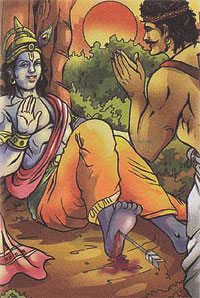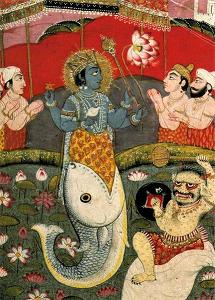|
Krishna

Alias: Krushna
Location: India
City: Dwaraka
Estimated Date: 1000s B.C. - 2000s A.D.
Both he and Vahagn are associated with Hercules
Vahagn was considered to be the idealization of victory, Verethraghna, and both were associated with the Hindu king of the Devas, Indra, as well as with the famous Greek demigod (or god-man) Heracles, who like Yahweh and Ba'al Hadad fought a multi-headed dragon, this one named Hydra. Greek myth expert Walter Burkett identifies a story of Heracles capturing cattle from the cave of a shape-changing opponent with a Hindu story about Indra’s fight against a shape-changing demon named Visvarupa which also had cows hidden in a cave. Indra, Mitra and Varuna are the triad of Adityas, the chief gods in the Rigveda, a collection of Indo-Aryan Vedic hymns written in Sanskrit between 1700 and 1100 B.C. In 305 B.C., the Seleucid explorer Megasthenes identified Heracles with either Krishna or his brother Balarama and identified three of the Hindu gods as manifestations of Dionysus: Indra, Shiva and Sankarsana. Krishna and Balamara are themselves attacked by horse-demons, similar to the 8th labor of Heracles in which he must defeat the man-eating Mares of Diomedes.
He is a cowherd
Krishna is a cowherd, similar to how Dumuzi, Adonis, Attis, Orpheus, Apollo and Marsyas are shepherds.
He is divinely conceived
Although Krishna was not born of a virgin, his conception was from the seventh incarnation of Vishnu. A stone bas-relief from the early first century A.D. depicts him being carried across the river Yamuna after his birth, an infancy narrative comparable to Sargon, Romulus and Moses in which a baby survives the dangers of being set on a river, a subset of a more generic myth in which the infant hero is exposed to the exposed to wilderness, as in the story of Oedipus.
He is accidentally hit by an arrow under a tree

According to the Bhagavata Purana, dated between 500 B.C. and 1030 A.D., he is fated to die while he is resting under a tree, just as Dumuzi and Attis were. In the most popular version, a hunter accidentally takes his foot for a deer and shoots him.
His “father” had the ark of the great flood built

Matsya, the first incarnation of Vishnu
Krishna is said to be the eighth incarnation of Vishnu the Preserver, whose name is etymologically related to village and –wich, implying an early association wtih working and settlement. He acted as a primordeal protector of mankind similar to the role of Dumuzi’s father Enki and the Titan Prometheus, who provided the arts of civilization to mankind. Both Enki and Vishnu are associated with fish and water. In the Matsya Purana, or “Fish Chronicle”, dated between the 300s and 500s A.D., the fish god Matsya, who like Krishna is an incarnation of Vishnu, warns Manu, whose name is etymologically linked to the English word “man”, to build a ship and tie it to the horn of a great fish, after which the flood waters would leave the ship on a mountain, leaving only him alive. Manu is also the first lawgiver, similar to the covenant with Noah in Genesis 6 that would become known as the Noahide Laws, which unlike the Laws of Moses, were also meant for non-Jews. Manu is also called Satyavrata (“The Honest One”), Sraddhadeva, Satyavarman or Vaivasvata, and like the Sumerian flood hero Ziusudra, he was a king (of Dravidia) before the flood. The story of the divine destruction of the deluge is also linked with the divine creation story, just as the watery creation and watery destruction are used in the Epic of Atrahasis. The Code of Manu explains reicarnation and describes the universe as a golden egg shell cracked in two pieces similar to how heaven and earth are split apart in Mesopotamian mythology. Although reincarnation is central to Hindu spirituality, which is shared with Orphism, the soul can eventually enter into Paradise or the netherworld. Just as with Mesopotamian mythology, there are seven heavens and seven hells.
His “father” created the food and drink of immortality
Krishna's apotheosis Vishnu convinces the gods to churn the primordial ocean called the Sea of Milk, like the Mesopotamian splitting of the primordial sea by the divine wind, in order to generate the Amrita, the nectar of immortality equivalent to the ambrosia of Dionysus. Dumuzi's father Enki, likewise, used the food and water of life to resurrect Dumuzi's wife Inanna. The Asura and Devas fight over the Amitra and Vishnu eventually manages to trick the Asuras into giving it to the Devas.
His cousin meets a fallen serpent god with the same name as the serpent pole used for healing by Moses
In the Mahabharata, dated between the 800s and 400s B.C, the king of the Devas, Indra, abandons his throne over the guilt of killing another god, causing the gods to replace him with Nahusha, who becomes increasingly prideful and tries to take Indra’s wife as his own. While being carried in a celestial chariot by the sage Agastya, Nahusha touched the sage with his foot, causing him to lose his power. Agastya then cursed him, causing him to fall from heaven and become a snake, but the curse was lifted from Nahusha when Krishna’s cousin Yudhishthira answered his questions regarding the duties of Dharma. The story rings of the same “hubris” motifs from the fall of Satan and Prometheus and uses the same snake imagery from the Eden story and Nehushtan, the bronze caduceus staff (Asherah pole?) that Moses lifted up so as to heal the Israelites of “fiery serpents” (Num. 21:6). This snake cult relic was later destroyed during the iconoclastic reformation of king Hezekiah (2 Kings 18:4). The caduceus, as mentioned earlier, has an ancient association with Dumuzi’s heavenly double, Ningishzida, as well as the wand assocaited with Apollo and Ascelpius.
Next God: Odin
The Dying-and-Rising Gods
Leave Comments Here
|

